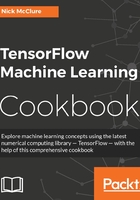
上QQ阅读APP看书,第一时间看更新
Additional Resources
Here we will provide additional links, documentation sources, and tutorials that are of great assistance to learning and using TensorFlow.
Getting ready
When learning how to use TensorFlow, it helps to know where to turn to for assistance or pointers. This section lists resources to get TensorFlow running and to troubleshoot problems.
How to do it…
Here is a list of TensorFlow resources:
- The code for this book is available online at https://github.com/nfmcclure/tensorflow_cookbook.
- The official TensorFlow Python API documentation is located at https://www.tensorflow.org/api_docs/python. Here there is documentation and examples of all of the functions, objects, and methods in TensorFlow. Note the version number r0.8' in the link and realize that a more current version may be available.
- TensorFlow's official tutorials are very thorough and detailed. They are located at https://www.tensorflow.org/tutorials/index.html. They start covering image recognition models, and work through Word2Vec, RNN models, and sequence-to-sequence models. They also have additional tutorials on generating fractals and solving a PDE system. Note that they are continually adding more tutorials and examples to this collection.
- TensorFlow's official GitHub repository is available via https://github.com/tensorflow/tensorflow. Here you can view the open-sourced code and even fork or clone the most current version of the code if you want. You can also see current filed issues if you navigate to the issues directory.
- A public Docker container that is kept current by TensorFlow is available on Dockerhub at: https://hub.docker.com/r/tensorflow/tensorflow/
- A downloadable virtual machine that contains TensorFlow installed on an Ubuntu 15.04 OS is available as well. This option is great for running the UNIX version of TensorFlow on a Windows PC. The VM is available through a Google Document request form at: https://docs.google.com/forms/d/1mUztUlK6_z31BbMW5ihXaYHlhBcbDd94mERe-8XHyoI/viewform. It is about a 2 GB download and requires VMWare player to run. VMWare player is a product made by VMWare and is free for personal use and is available at: https://www.vmware.com/go/downloadplayer/. This virtual machine is maintained by David Winters (1).
- A great source for community help is Stack Overflow. There is a tag for TensorFlow. This tag seems to be growing in interest as TensorFlow is gaining more popularity. To view activity on this tag, visit http://stackoverflow.com/questions/tagged/Tensorflow
- While TensorFlow is very agile and can be used for many things, the most common usage of TensorFlow is deep learning. To understand the basis for deep learning, how the underlying mathematics works, and to develop more intuition on deep learning, Google has created an online course available on Udacity. To sign up and take the video lecture course visit https://www.udacity.com/course/deep-learning--ud730.
- TensorFlow has also made a site where you can visually explore training a neural network while changing the parameters and datasets. Visit http://playground.tensorflow.org/ to explore how different settings affect the training of neural networks.
- Geoffrey Hinton teaches an online course, Neural Networks for Machine Learning, through Coursera. Visit https://www.coursera.org/learn/neural-networks
- Stanford University has an online syllabus and detailed course notes for Convolutional Neural Networks for Visual Recognition. Visit http://cs231n.stanford.edu/